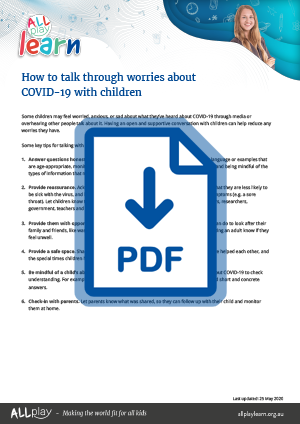
How to talk through
worries about COVID-19
with younger children

Some children may feel worried, anxious, or sad about what they’ve heard about COVID-19 through media or overhearing other people talk about it. Having an open and supportive conversation with children can help reduce any worries they have.

Answer questions honestly, and keep your answers child-friendly. Consider using language or examples that are age-appropriate, monitoring how children are reacting throughout the conversation, and being mindful of the types of information that might cause distress (e.g. talking about deaths).

Provide reassurance. Acknowledge children’s concerns and feelings, and remind them that they are less likely to be sick with the virus, and if they do have the virus they will probably experience mild symptoms (e.g. a sore throat). Let children know there are many adults working to keep their family safe: doctors, researchers, government, teachers and cleaners.

Provide them with opportunity to take action. Talk to children about the things they can do to look after their family and friends, like washing their hands, sneezing/coughing into their elbow, and letting an adult know if they feel unwell.

Provide a safe space. Share positive stories about this time – about the ways people have helped each other, and the special times children have had with their family while staying at home.

Be mindful of a child’s abilities. Some children may need one-on-one conversations about COVID-19 to check understanding. For example, some children with autism or intellectual disability may need short and concrete answers.

Check-in with parents. Let parents know what was shared, so they can follow up with their child and monitor them at home.

